This was published 2 years ago
Sydney’s cultural tsar-in-waiting is unapologetic about his most controversial moves
By Linda Morris
NSW’s newest cultural tsar-in-the-wings was once a lifestyle consultant with American Express for its mega-rich clients.
Adam Lindsay’s first job out of school was manning a 24-hour desk catering to the needs of AMEX’s Century cardholders: he booked luxury travel, and organised weddings and home renovations.
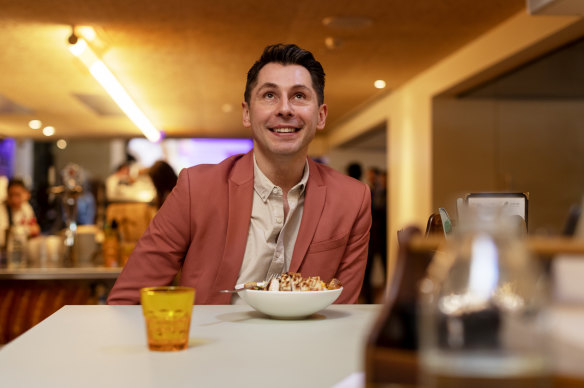
Adam Lindsay dines at This Way Canteen in the foyer of the Museum of Sydney.Credit: Nikki Short
“I remember this Sunday morning I got a call from this woman, in tears and distraught,” Lindsay recalls. The woman’s best friend, who was Aboriginal, had been given two hours to live, and her dying wish was for a didgeridoo player at her bedside as she passed away. “I said, ‘Leave it with me’.”
Lindsay went from art gallery to council officer to track down an artist able to perform the moving bedside vigil.
Such a quixotic career path has led a can-do Lindsay to this moment as chief executive of Sydney Living Museums, the old Historic Houses Trust and the State Archives, shepherding through the creation of a new flagship cultural institution that will bring together 12 museums and the state’s $1 billion archives collection.
Lindsay will throw his hat in the ring for the job heading the newly minted Museums of History NSW when it is advertised in coming weeks.
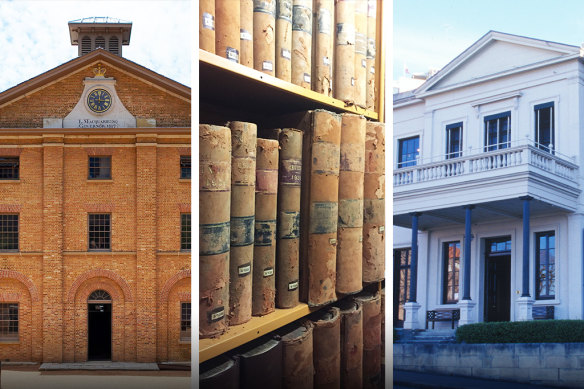
The new Museums of History NSW will incorporate the Hyde Park Barracks, the state archives collection and Elizabeth Bay House.Credit: SMH
The new body will have carriage of key real estate along Macquarie Street: The Mint and the World Heritage-listed Hyde Park Barracks, as well as the house museums of Rose Seidler House, Elizabeth Bay House, Elizabeth Farm, Susannah Place and Rouse Hill Estate, among others.
What’s more, it’s no secret that the state’s No. 1 history buff, Premier Dominic Perrottet, is mad keen on adding to its portfolio a new museum dedicated to the 60,000 years of this state’s history in the old Registrar General’s building, next door to St Marys Cathedral.
Perrottet telegraphed as much when he foreshadowed that the annex behind the Victorian Gothic building would be knocked down for a plaza honouring the late Queen Elizabeth II.
It’s just a matter of how the government justifies the funding of a multimillion-dollar state history museum on Macquarie Street when western Sydney has called for its location in Parramatta, equivalent funding of the female convict site, the Female Factory, and clamours for a fairer share of the cultural funding pie.
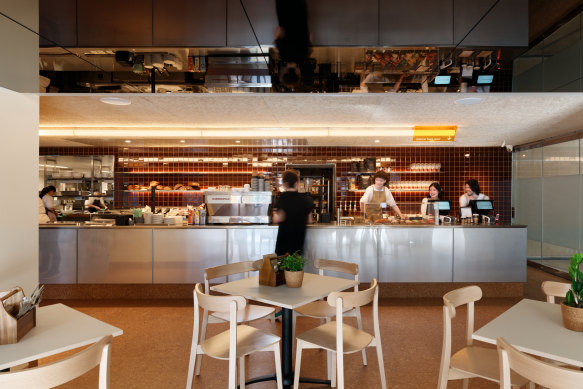
This Way Canteen brings NY deli-style sandwiches to the Museum of Sydney forecourt.
We are sitting in This Way Canteen, the newly opened New York-style deli on the ground floor of the Museum of Sydney, on the former site of the First Government House. It’s a venture by Stephen Seckold, former executive chef of Pyrmont’s Flying Fish.
The foyer of the Museum of Sydney has been opened up to the diner and, on the far wall, a light installation is being tested for unveiling in early 2023. A summer program of festivities is planned for the forecourt.
The installation signals, says Lindsay, that “something is changing here”.
“I do worry about why people think history is dusty – dusty, old, boring. It’s not. I do really want to change that. The museum of the future is going to be an amazing place. I see a deep focus on localism – experiencing stories, objects in their place of provenance.
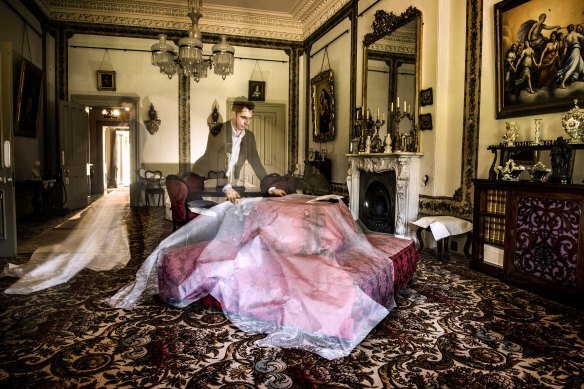
Lindsay, pictured at Vaucluse House, wants museums to shake off their image as dusty or boring. Credit: Steven Siewert
“I think that museums will evolve, like libraries have in the last 10 or 15 years, and find ways to put more of their collections on show. I think the 3 to 5 per cent average will become unacceptable in future. I see a deep call for expertise – not just research and curatorial but the entire inner workings of museums being put on show and making room for citizen science and perspective.”
Lindsay orders a soy piccolo, his third of the day, and a caesar salad. The house-made garlic falafel focaccia sandwich arrives with layers of artichoke, baba ganoush, and a garlic chilli sauce.
The evergreen 40-year-old grew up in the Wollongong home of grandparents, surrounded by five aunts and uncles who spoke their own version of Pidgin English, an eccentricity he picked up. To demonstrate, he repeats my lunch order back to me, and it sounds fluent yet impenetrable. His grandfather was a butcher, a trade known for its own secret language.
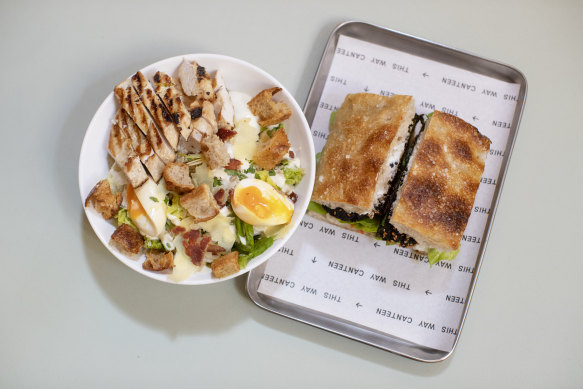
This Way Canteen’s chicken caesar salad and garlic falafel sandwich.Credit: Nikki Short
“I grew up without television, and so I read voraciously, and I read anything,” he says. “I was the eldest grandchild, so I got a lot of adult attention. I wasn’t great at interacting with kids. I would go to preschool in all-white and I would return in all-white after having spent the day in the room with the teachers.”
Every afternoon after homework was complete he would present a mini-research project to his grandparents on their preferred topic.
“I’ve still got a book of knowledge that my grandfather gave me when I was eight. He said, ‘If you learn what’s in there, you can be prime minister.’ So I set about studying to read it, and I’m still not prime minister.”
Smart, sharp and ambitious, Lindsay is a minimalist in all things but books; he keeps thousands of them in his apartment, garage and in storage. His other love is the visual arts. Only days after his HSC, he acted in a stage adaption of Morris Gleitzman’s Two Weeks with the Queen that toured Britain.
From American Express, Lindsay went to the federal department, overseeing the delivery of digital television to remote Indigenous communities, to Woolworths’ head office, to assistant director at the Queensland Gallery of Art.
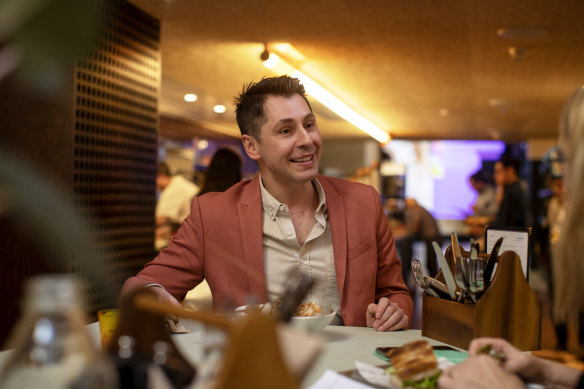
Adam Linday’s fast ascension through the ranks raised eyebrows,Credit: Nikki Short
Three years later, he joined the State Archives and Records Authority (SARA) in Sydney, became its director within 15 months of arrival, and went on to lead Sydney Living Museums a year later.
His fast ascension through the ranks raised eyebrows, but Lindsay says he won his job “fair and square” and no one has worked harder to find ways to reach new visitors. “It wasn’t a ministerial appointment,” he says.
There is, however, tension in Lindsay’s methods to bring history to life in this age of distraction, loneliness and disconnection.
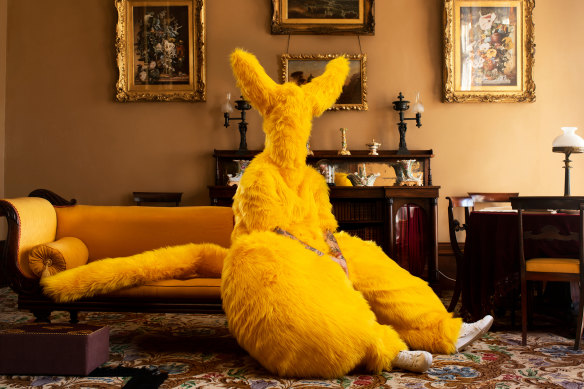
Gerwyn Davies’ work Iridescent raised some eyebrows.
In making the stately homes of Australia’s colonial past relevant to a broader audience, Lindsay has looked to contemporary art installations. This year, acclaimed photo media artist Daniel Crooks projected scenes from its museums onto a giant screen in front of the Hyde Park Barracks. But artist Gerwyn Davies’ yellow creature sitting among the elegant furnishings of Elizabeth Bay House, part of an exhibition called Iridescent, was deemed a bridge too far by some.
Lindsay is unapologetic: “It’s our job to get people in here and immerse them in history. If people want to think that’s cheap, I can assure them it is not, it’s a way of signalling to all people that their view on history is just as valid as everyone else’s.”
Lindsay has also varied the opening times of Sydney Living Museums’ 12 properties following an operations review. For the first time in a decade, the Museum of Sydney is open seven days a week, but Rouse Hill Estate now opens to the public one Sunday a month for general visitors, with weekdays devoted to school visits.
Even more controversial is the decision to turn the Museum of Sydney, site of the first Government House, into an Aboriginal cultural centre, rather than support a national Indigenous cultural centre based at The Cutaway in Barangaroo.
Metropolitan Local Aboriginal Land Council chief executive Nathan Moran has dismissed this enterprise as colonialism 101.

Bill, please.
“The fact that this is ground zero for the meeting of two cultures, that’s what makes this site special,” Lindsay says. “Every decision about the colony, not just the people who were transported here, but every decision about Aboriginal people, was made here for 57 years. It’s not about taking away but adding Aboriginal perspectives.”
Lindsay points to the 11 models of the First Fleet in the Museum of Sydney. The intention is not to remove them – that would be colonial erasure, he says. “When visitors walk in and see the ships, some are disgusted by the colonial impact, others are proud to have a colonial ancestor, some have no idea what they are about and read to learn more, others like the complexity of the models and disregard the symbolism. There is room for all of these perspectives, in addition to the curatorial and historical research. And we welcome it all.”
Not only has Lindsay’s team at Sydney Living Museums developed options for a new museum of history – which he does not reveal on the basis of cabinet confidence – but an interactive museum at the Parramatta Female Factory, a neglected site deemed worthy of World Heritage listing.
“What we are going to take to government is a museum experience in four parts,” Lindsay says.
“An immersive experience that looks at the real history and stories and lived experiences through all eras, pre-colonial, female factory, mental asylum, and then more traditional health.
“The earliest Lithium drug trials in the world started there; such heartbreaking stories. The second part is a landscape of stories, and that allows people to go deep into certain elements of history, be it a glimpse into the deprivations of solitary confinement, or one idea is a space where people can bring memorabilia. The third part is a learning centre aligned with the school curriculum.
“In the two biggest master plan options the learning centre is very expansive and has indoor and outdoor areas allowing for a very meaningful learning experience for kids and hopefully a day for teachers to enjoy. Plus, there are many opportunities for activations and community programming.”
Long ago, Lindsay says he was persuaded by his grandparents not to take up an acting career. Regretting not standing up for himself, it’s a life lesson he applies to his museums’ job: “If you’re going to make the right decision or a wrong decision, make it your own decision and have the guts and gumption to either have the glory. Or not.”
A cultural guide to going out and loving your city. Sign up to our Culture Fix newsletter here.